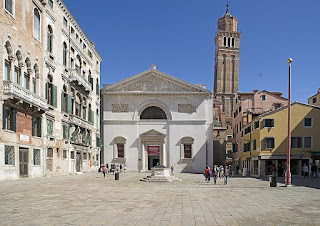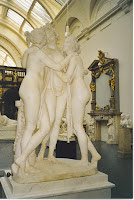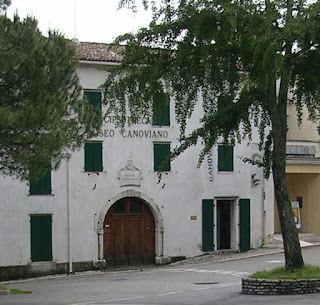Genius who could bring marble to life
 |
A self-portrait of Canova, painted
in about 1790 (Uffizi, Florence) |
Sculptor Antonio Canova was born on this day in 1757 in Possagno in the Veneto.
Considered to be the greatest Neoclassical sculptor of the late 18th and 19th centuries, Canova became famous for creating lifelike figures, possessing the ability to make the marble he worked with resemble nude flesh. One of his masterpieces is the group, The Three Graces, now in the Victoria and Albert museum in London.
Canova’s father and grandfather were both stone cutters and his grandfather taught him to draw at an early age. By the age of 10, living in the care of his grandfather after his father died, he had carved two small shrines in Carrara marble.
The noble Falier family of Venice took an interest in Canova’s talent and brought him to the city at the age of 12 to learn his trade in the workshop of Giuseppe Bernardi, who was also known as Torretto. He enrolled at the Accademia di Belle Arti di Venezia, where he won a number of prizes.
He was commissioned by Giovanni Falier, a senator, to produce statues of
Orpheus and Eurydice for the garden at his villa in Asolo, another town in the Veneto. In 1779, Canova opened his own studio in the Campo San Maurizio in Venice in the San Marco sestiere.
Canova also studied anatomy, history and languages and in 1780 moved to work in Rome, where he studied the work of Michelangelo among others. He opened a studio there there and his first big successes included a sculpture of Theseus and the Minotaur, commissioned by the Venetian ambassador to Rome and now housed at the Victoria and Albert museum in London, and his funerary monument to Clement XIV, which was inaugurated in the Basilica dei Santi Apostoli.
 |
The Campo San Maurizio in Venice, where the
young Canova opened his first workshop |
He became the most celebrated artist in Europe, acquiring patrons from across the continent. He travelled to France, where he received several commissions from Napoleon Bonaparte, including a statue of the French leader as Mars the Peacemaker, which ultimately fell into the hands of the Duke of Wellington after his victory at the Battle of Waterloo.
He returned to Rome and was appointed Inspector-General of Antiquities and Fine Art of the Papal State, a position formerly held by Raphael. He was charged with restoring the tomb of Servilius Quartus, as part of a project to restore the Appian Way.
In 1816, Pope Pius VII rewarded Canova with the title of marquis of Ischia after he arranged for the return of Italian art looted by the French. The title came with an annual pension. At the same time he was working on The Three Graces, a sculpture that would be considered one of his finest works.
Completed in 2017, it depicted the daughters of Zeus from Greek mythology, namely Euphrosyne, Aglaea and Thalia, who were meant respectively to represent mirth, elegance and youth or beauty.
 |
The Three Graces
at London's V&A |
His first version, in terracotta, is now in a museum in Lyon. A marble version was made for the Empress Josephine, the estranged wife of Napoleon Bonaparte, which is now in a museum in St Petersburg, Russia.
He was commissioned to make another group of The Three Graces in 1814 for Woburn Abbey by the sixth Duke of Bedford, who visited the sculptor in his workshop in Rome. It is this version that can be seen in the Victoria and Albert museum in London.
Still working but in declining health, Canova died in Venice at the age of 64 and was buried in Tempio Canoviano in Possagno, the town of his birth. Canova’s heart was interred in a marble pyramid he had designed as a mausoleum for the painter, Titian, in the Frari church in Venice.
 |
Canova's heart was buried at the
Frari church in Venice |
Travel tip:
Canova’s heart is buried in a marble pyramid designed by himself, in the Basilica di Santa Maria Gloriosa dei Frari in Venice. This huge Gothic-style church, the largest in the city, is in the San Polo sestiere. It is one of three notable churches in Venice that still retain their Venetian Gothic appearance. The current edifice, work on which began in around 1340, took more than a century to complete. The Frari, as it is usually known, also houses the tombs of Monteverdi, Rossini and Doge Nicolo Tron as well as works of art by Titian, Bellini and Donatello. The church is open daily from 9.00 to 5.30 pm and on Sundays from 1.00 to 5.30 pm.
 |
The Gipsoteca Canoviana museum has become
a tourist attraction in Possagno |
Travel tip:
Possagno is a small hilltop town in the Veneto region, about 60km (37 miles) northwest of Venice and about 35km (22 miles) northwest of Treviso. The Tempio Canoviano, a church built in a severe Neoclassical style, with a facade of eight marble columns designed, financed, and in part built by Antonio Canova, has become one of the city's landmarks along with the museum of the Gipsoteca Canoviana, which houses various plaster casts of his most famous works as well as many of his paintings.










